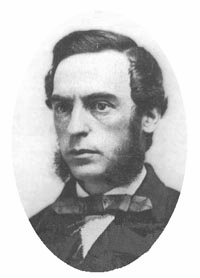Mark Kellogg (reporter) facts for kids
Quick facts for kids
Mark Kellogg
|
|
|---|---|

Date and photographer unknown.
|
|
| Born |
Marcus Henry Kellogg
March 31, 1831 Brighton, Ontario, Canada
|
| Died | June 25, 1876 (aged 45) Near the Little Bighorn River in the eastern Montana Territory
|
| Nationality | American |
| Occupation | Newspaper reporter |
Mark Kellogg (born March 31, 1831 – died June 25, 1876) was a newspaper reporter. He was killed during the famous Battle of the Little Bighorn. Kellogg rode with George Armstrong Custer and his soldiers. His news reports were the only ones from Custer's group before the battle. Kellogg was a special kind of reporter called a stringer. His stories were printed in newspapers all over the country. He is known as the first Associated Press correspondent to die while doing his job.
Early Life and Career
Mark Kellogg was born Marcus Henry Kellogg on March 31, 1831. He was born in Brighton, Ontario, Canada. He was the third of ten children in his family. His family moved several times when he was young. They finally settled in La Crosse, Wisconsin. There, Kellogg learned how to use a telegraph machine. He worked for two telegraph companies.
In 1861, he married Martha J. Robinson. They had two daughters together. During the American Civil War, Kellogg became an assistant editor. He worked for the La Crosse Democrat newspaper.
In 1867, Kellogg's wife passed away. He left his daughters to be raised by their aunt. Kellogg then traveled around the upper Midwest. He worked as a reporter and editorial assistant. He worked in places like Council Bluffs, Iowa, and Brainerd, Minnesota. While in Brainerd, he wrote for the St. Paul Dispatch. His articles were often published under the name "Frontier."
In the early 1870s, he moved to Bismarck, North Dakota. In 1873, he helped Clement A. Lounsberry start The Bismarck Tribune newspaper. Kellogg was an editorial assistant. He even filled in as editor for some early issues of the Tribune.
Reporting the Battle of the Little Bighorn
Clement Lounsberry, the editor, learned about a military group. This group included the 7th U.S. Cavalry Regiment. It was led by Lt. Col. George Armstrong Custer. The group was leaving Fort Abraham Lincoln for the Montana Territory. Lounsberry planned to go with Custer to report the news.
However, Lounsberry's wife became sick at the last minute. So, he asked Kellogg to go in his place. Lounsberry thought Kellogg would only report on a big military victory.
Kellogg sent three news reports back to Lounsberry. His last report was sent four days before the battle. They were near the Rosebud River at that time. His final message said, "By the time this reaches you we would have met and fought the red devils, with what result remains to be seen. I go with Custer and will be at the death." When he said "at the death," he did not mean he would die. It is a phrase from fox hunting. It means "present at the kill," or being there for the end of the hunt.
Four days after that report, the Battle of the Little Bighorn happened. Custer and 208 soldiers, scouts, and civilians died. Mark Kellogg was among them.
After the Battle
Colonel John Gibbon and his soldiers arrived at the battle site on June 27. They helped bury the dead. Colonel Gibbon said he found Kellogg's body in a ravine. Many men from Company E had died there. Kellogg was identified by the boots he was wearing.
When Clement Lounsberry heard about Custer's defeat and Kellogg's death, he worked very hard. He stayed up all night to create a special edition of The Bismarck Tribune. It was published on July 6, 1876. This article was the first full report of the battle. Lounsberry also sent the news by telegraph to many eastern newspapers. This included the New York Herald. Two letters written by Kellogg were published in the Herald on July 11, 1876.
Because his reports were printed across the country, Kellogg is seen as important. He is considered the first Associated Press correspondent to die while on duty.
Some of Kellogg's diary and notes survived the battle. These, along with his news reports, are important historical sources. They tell us about the days leading up to the battle. His notes are now kept by the State Historical Society of North Dakota. His satchel, pencil, and eyeglasses are on display. You can see them at the Newseum in Washington, DC.
See also
 In Spanish: Mark Kellogg para niños
In Spanish: Mark Kellogg para niños

